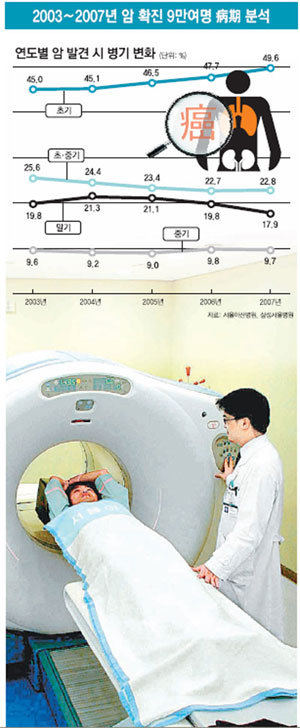30 Pct. of Cancer Patients Diagnosed After Mid Stage
30 Pct. of Cancer Patients Diagnosed After Mid Stage
Posted May. 27, 2008 08:53,

Restaurateur Park Eun-woo had long prided himself on being healthy. The 46-year-old man had rarely caught a cold and was far from scared when the National Health Insurance Corp. asked him to get a comprehensive medical check-up two years ago.
Surprisingly blood was found in his urine. He immediately had an endoscopy at a university hospital and was diagnosed with bladder cancer.
Doctors later removed the cancer cells in Parks bladder through endoscopic treatment without chemo and radiation therapy since the cancer was detected in the initial stage. He regularly gets checked for metastasis or a recurrence twice a year.
Park is lucky in that his cancer was detected early.
Analyzing materials from Asan Medical Center and Samsung Medical Center on cancer diagnoses of 90,125 patients between 2003 and last year, The Dong-A Ilbo found that 30 percent had their cancers detected after mid stage when cancer cells spread to other organs.
The material followed The SEER Summary, a stage manual written by the National Cancer Institute which categorizes 21 cancers by how severe their conditions are at the time of initial diagnosis. The early stages are classified Stages 0 and 1; early to mid stages Stages 2 and 3; the mid stage Stage 4; end stages Stages 5 to 8; and unknown is Stage 9.
Among 115,018 patients whose cancers were confirmed, the study excluded 24,893 who either had stage data omitted or contracted Stage 9 cancer, which is impossible to tell when the cancer began since cancer cells spread to multiple organs.
This analysis was the first on cancer stages of patients at the initial diagnosis of 21 cancer types.
The study found 46.9 percent of patients discovered cancer in the early stages, where cancer cells are found on epidermal cells or in extremely limited parts of organs. Though 23.7 percent found cancer between the early and mid stages by definition, it was closer to the early stages since cancer spreads only to either neighboring organs or lymph nodes.
On the other hand, 9.5 percent discovered cancer in the mid stages, when cancer spreads to both neighboring organs and lymph nodes, while 19.9 percent detected it after cancerous cells reached remote organs from the initial organ afflicted. In other words, about 30 percent of patients were diagnosed with cancer after the disease reached the mid stages.
Patients were more likely to detect brain cancer (89.1 percent), bladder cancer (80.9 percent) and cervical cancer (79.9 percent) earlier than other cancer types. Bone cancer (97.4 percent), lymphoma cancer (63.9 percent) and ovarian cancer (55.6 percent) were more likely to be found in the end stages.
corekim@donga.com







